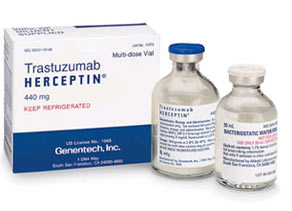Detailed Herceptin Mechanism of Action

Effect on Receptor signaling
As briefly described previously, the overexpression of HER-2 (HER2 is one of 4 trasmembrane tyrosine kinase receptors of the HER family) genes activates numerous cellular signaling pathways, including the PI3 kinase (PI3K) and MAP kinase (MAPK) cascades. The complementary binding of Herceptin molecules with the HER2 antigens have shown to reduces signaling from these pathways, and consequently promoting cell cycle arrest during the G1 phase of cell cycle and apoptosis.
Effect on Cell cycle and Apoptosis
The cell cycle arrest is closely regulated by the presence of cyclin-dependent kinase (cdk) inhibitor p27kip1. The presence of p27kip1 in turn inhibits cyclin E/cdk2 complexes. Herceptin molecules promote cell cycle arrest by accumulating p27kip1 and also induces apoptosis.
Apoptosis is one of the main forms of programmed cell death (PCD) during the cell cycle. One important function of apoptosis is to repair any damage or mutations in the DNA in response to prevent cancer developing. Herceptin has shown to reduce the size of tumour cells by either having a direct cytotoxic effect on the tumour cells or indirectly via activation of body’s immune system to respond and suppress the tumour cells.
Effect on Angiogenesis
Angiogenesis is the extension/formation of new blood vessels from existing ones. Tumour cells migrate and enlarge by actively taking in nutrients from blood vessels developed by the process of angiogenesis. The overexpression of HER-2 is closely linked to high level of angiogenesis -this is another evidence that HER2 is the proto-oncogene for breast cancer. Clinical trials have shown that Herceptin can lower the level of angiogenesis.
Acknowledgement
Thanks to Mr. Yi Wei T for finding the literature below.
References
1. Rita Nahtaa and Francisco J. Esteva, Herceptin: Mechanisms of action and Resistance, 2006, 232,DOI: doi:10.1016/j.canlet.2005.01.041
